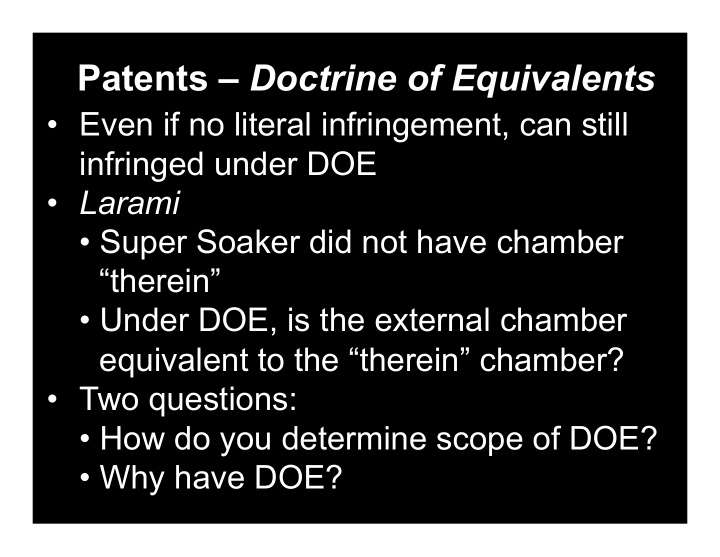



Patents – Doctrine of Equivalents • Even if no literal infringement, can still infringed under DOE • Larami • Super Soaker did not have chamber “therein” • Under DOE, is the external chamber ✔ ✖ equivalent to the “therein” chamber? • Two questions: • How do you determine scope of DOE? ✖ • Why have DOE?
Patents – Doctrine of Equivalents • Warner-Jenkinson v. Hilton Davis Claim ¡ Warner-‑Jenkinson ¡ “ultrafiltra(on ¡through ¡a ¡ ¡ ¡ ¡ ¡ ¡ ¡ 5-‑15 ¡Ang. ¡ ¡ ¡ membrane ¡having ¡a ¡nominal ¡pore ¡ diameter ¡of ¡5-‑15 ¡Angstroms” ¡ “under ¡a ¡hydrosta(c ¡pressure ¡of ¡ 200 ¡to ¡500 ¡p.s.i.g. ¡ ✔ ✖ approximately ¡200 ¡to ¡400 ¡p.s.i.g.” ¡ “at ¡a ¡pH ¡from ¡approximately ¡6.0 ¡ above ¡9.0 ¡pH ¡ to ¡9.0” ¡ ✖ • Is above 9.0 pH = to 6.0-9.0 pH?
Patents – Doctrine of Equivalents • “All-Elements Rule” • Need equivalent for each element • Present in Warner-Jenkinson • Determine equivalency • “Triple Identity” test • substantially the same function ✔ ✖ • substantially the same way • achieve substantially same result ✖ • “way” is usually the critical inquiry • “Insubstantial Difference” test
Patents – Doctrine of Equivalents • Hughes Aircraft v. U.S. Claim ¡ U.S. ¡Satellite ¡ “means ¡. ¡. ¡. ¡providing ¡an ¡ means ¡is ¡a ¡ indica(on ¡to ¡a ¡loca(on ¡external ¡to ¡ computer ¡on ¡ said ¡body ¡. ¡. ¡. ¡” ¡ satellite ¡ “means ¡. ¡. ¡. ¡receiving ¡from ¡said ¡ NOT ¡receive ¡signals ¡ loca(on ¡control ¡signals ¡. ¡. ¡. ¡” ¡ ✔ ✖ “synchronism” ¡ does ¡synchronism ¡ • all elements problem ✖ • classic “after-arising” technologies ex. • what about triple identity test?
Patents – Doctrine of Equivalents • Why? DOE ¡ PRIOR ¡ART ¡ Literal ¡Claim ¡ ¡ Scope ¡ ✖ • Equity ✖ • Make-up for imperfections of language • Policy
Patents – Indirect Infringement • Two Types: • 35 U.S.C. § 271(b) “Whoever actively induces infringement of a patent shall be liable as an infringer.” ✔ ✖ • Inducement of Infringement ✖
Patents – Indirect Infringement • 35 U.S.C. § 271(c) “Whoever offers to sell or sells . . . a component . . . or a material . . . for use in practicing a patented process, constituting a material part of the invention, knowing the same to be especially made or especially adapted for use in an infringement of such patent, and not a staple article or ✔ ✖ commodity of commerce suitable for substantial noninfringing use, shall be liable ✖ as a contributory infringer.” • Contributory Infringement
Patents – Indirect Infringement • Must have a direct infringer • One that is being induced or contributed to • Two typical situations: • induce the infringement of a method ✔ ✖ claim • contribute to infringement of product ✖ claim
Patents – Indirect Infringement • C.R. Bard v. ACS • Method claim: • insert catheter into coronary artery • openings in catheter draw ✔ ✖ blood from artery ✖
Patents – Indirect Infringement • C.R. Bard v. ACS • ACS catheter sells catheters with openings placed by doctors: • all in coronary artery • all in aorta • partially in coronary artery ✔ ✖ • Two likely infringe (in coronary), one does not ✖ • claim interpretation question
Patents – Contrib. Infringement • C.R. Bard v. ACS • Contributory Infringement • Is ACS’s catheter a “staple article” or “capable of substantial non-infringing uses”? • What is the common use? ✔ ✖ • 40-60% of uses less than 3 cm from entrance of coronary artery ✖ • openings range from 3mm to 6.3 cm from balloon on ACS device
Patents – Induced Infringement • C.R. Bard v. ACS • Induced Infringement • Is ACS “actively and knowingly inducing” doctors to infringe • What would be evidence of this? • instructions to doctors ✔ ✖ • location of the openings ✖
Patents – Induced Infringement • S.Ct. in Global Tech. v. SEB (2010) • Alleged indirect infringer must: • know that the induced acts constitute patent infringement • deliberate indifference to a known risk that a patent exists does not ✔ ✖ satisfy the knowledge required by § 271(b); willful blindness does ✖ however
Patents – Indirect Infringement • Why? • Efficient enforcement • If standards met, infringer is “profiting” from direct infringement • Worry about expanding exclusivity beyond scope of patent claim ✔ ✖ ✖
Recommend
More recommend